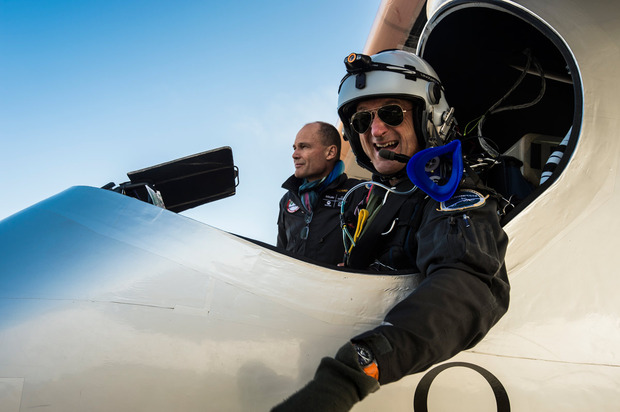Charged: Solar Impulse 2
Flying around the world without a drop of fuel (again) in the space-age aircraft is just the beginning

It’s staggering to think that, within less than a century, we’ve gone from Charles Lindbergh piloting the first solo transatlantic flight—Long Island to Paris in the Spirit of St. Louis—to two Swiss adventurers on the cusp of circumnavigating the globe in a solar-powered aircraft without so much as a drop of fuel (again). But that’s exactly what’s expected to happen next spring, following a year of test flights beginning this May, when the second iteration of their “flying laboratory,” dubbed Solar Impulse 2 (Si2), goes wheels-up.

“The airplane itself is not limited—we just have to work on pilot endurance,” says engineer-fighter pilot André Borschberg. Borschberg developed the 12 years-in-the-making aircraft with explorer-hypnosis psychiatrist Bertrand Piccard—who also co-captained the first non-stop, round-the-world balloon flight with Brian Jones 15 years ago. “In French, when we say ‘impulse’ it means to set something in motion,” Piccard says. As a third-generation explorer whose great-grandfather invented the pressurized cabin, Piccard knows a thing or two about the subject. “My family always used doubts and questions marks to stimulate curiosity, so I didn’t have to understand why I’m doing this project. I just try to make it possible.”

That’s another way of saying that Si2 is not simply a feat of technology. With 17,248 solar cells atop a carbon fiber plane the size of a 747 that weighs less than an SUV, it also serves as a platform through which we might broaden the discussion about sustainability. “There are two sides to this project: the human adventure and the fact that the technology can be used for houses, insulation, light structures, airplanes and cars,” says Piccard. “We can create millions of jobs and new industries that are vital for future markets.”

While the duo doesn’t anticipate a commercial solar flight in the near future, they hope that with any luck Si2’s technologies should help lead the next push in the clean tech revolution. The Si2 utilizes the same structural carbon fiber sheets used for the hull of the America’s Cup-winning Swiss sailboats, which are three times lighter than a sheet of paper. This is followed with solar cells as thin as a human hair protected by a waterproof-UV resistant fluorine copolymer resin and ultra-rigid, thin-pore foam that protects against extreme temperatures, all of which push the limits of contemporary aviation. “In five years we could have unmanned, high-altitude, solar-powered aircraft replacing satellites,” says Borschberg. Piccard adds, “This could open up a market for making cheap telecommunications available for developing countries. You could literally keep a solar plane flying overhead for years.”

Piccard hopes for another breakthrough within that five year plan: a two-man version of Si2 so they can make the round-the-world trip without stopping every five days to change pilots. Despite a flight regimen that includes meditation, hypnosis, 20-minute polyphasic sleep cycles and a rigorous exercise and diet schedule overseen by top nutritionists, currently the stops are still necessary.
“What we are doing, it’s a life project. It’s not a job,” Borshberg says. “It’s much more than aviation; there’s the technology, the human side and the education. There are so many people we can touch with this project.”
Images courtesy of Solar Impulse












